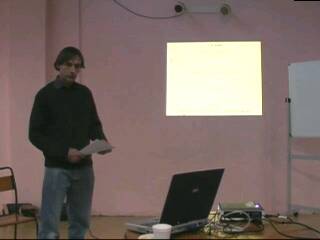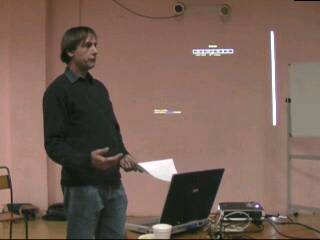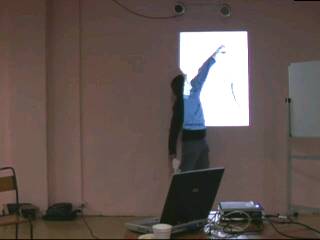


Rainer Linz - A theatre of interaction
reviewed by John Jenkins
Rainer Linz is a composer of instrumental and electronic music, who has also extensively explored challenging ideas in music theatre and performance. The publisher of New Music Articles, he was a recipient of the Australia Council's 2002/3 New Media Arts Fellowship.His formative period was in the 1970s, after exciting new impulses in music of the 1960s already seemed to him "to be fading away", at the advent of the so-called 'crisis in modernism'. There was a sense then that "everything that could be done had already been done, and there were no new ideas". Linz saw his role as taking up the challenge to produce 'forward-looking music' in the face of this.
He was not interested in work with a "narrative or representational" impulse, nor did he want to embrace "any sort of 'neo' practice", as a reaction against modernism. Rejecting 100 years of the modernist tradition also seemed to him to oblige practitioners to suggest viable alternatives.
His solution was a seemingly simple strategy: that of attending closely "to the world around me…" His work would grow out of "…an intense practice of listening and observing", and leading to a "causal analysis" of the relationship between movement and sound.
The process suggested new forms of music theatre, and he began working with the ambiguity that arises when sounds are treated in terms of actions, and actions in terms of sounds.
An early work, Theatre Book (1978), incorporated "found pieces and found scripts" that became the basis for performances in which the distinction between performers and audience members was often blurred.
Also from Theatre Book , was a piece "meant to take place while another performance was taking place". This piece explored the "distraction effect" of scripting seemingly tangential or accidental performances that intersected with 'official' ones.
In his orchestral piece, Saturn Winds (1982), the orchestra is seated around the audience. What an audience member hears depends on where they are sitting, as well as on what is being played. The piece is scored in such a way to give the conductor the option of selecting from various movements, and thus of taking several paths through the score. This means it remains "the same piece according to logic", but becomes "many independent pieces in actual performance".
In retrospect, Linz regards this piece – and the obdurate conservatism it exposed for him, in the 'difficulty' of its realisation - as perhaps a sort of "dissolution of the orchestra," and certainly of his interest in it.
The composer then turned to a more flexible medium: that of radio, which opened up new ways for him to include the audience as part of the work. In some radio formats – such as talkback and exercise programs – the element of audience participation was already built-in.
Talking About Music is a collage piece including live-to-air talkback, studio interviews, station promos, advertisements, and multiple versions of the song 'My Way'. The show sounded spontaneous, but everything was scripted down to the last detail. Studio announcers in live interviewing situations were given various scripts. For example, for caller one, agree with everything he or she says; for caller two, disagree; etc. In some ways, this piece was about remaining alert, and listening very carefully, rather than treating radio as a vague background companion. Alert listeners would have eventually understood what was happening, and how they, the information, and the familiar radio formats, were all being manipulated.
Linz says, "listeners were being subjugated to an undisclosed agenda", and this was, in many ways, a reflection and critique of the regrettably ubiquitous and manipulative "cash-for-comment" style of radio talkback.
Apparitions (1981) is a music theatre piece, with parts allocated for all those contributing to the piece as a whole, including various performers, musicians and the audience. It included "interminable introductions, questions and responses", with parts triggered by audience responses: for example, a specific verbal response.
The composer points out that, "…the primary narrative emerging from these early pieces was the story of the relationship between the listener and the piece itself."
Linz then became immersed in scientific investigations into the effects of music on the human body. He sifted through hundreds of laboratory studies, some going back many decades. He looked at charts from the Muzak Corporation. He pored over the 'distraction effects' of noise and music, and studies monitoring its effect on concentration and alertness. This data had much to say on how sounds – and their frequency, intensity, tonal colour, source and other factors – affected pulse rates, muscle tonus and metabolic factors. In turn, this led to a notion of 'listening with the body'. And, with Muzak, as he noted, the "mechanism of musical affect" had not just been codified, it had also been industrialised.
Linz then discussed his ongoing work with the Australian performance artist, Stelarc, which has involved various monitors and sensors picking up signals from the artist's body. As well as responding to music, the body could also become an instrument. It could generate pulses and signals, which in turn could be used to modulate synthesised sounds. The body could be monitored, and its sounds amplified, treated and used in compositions.
Electronic music, as Linz notes, "…has a 'pre history', and musicians were making music with electricity well before electronic technologies had been developed. Music is also the earliest of the interactive arts, and can be said to have a home on the Internet as well on radio, on compact disc, and so on."
Most recently, Linz has been working on a series of small Web-based music-making machines, realised through Java code. Briefly, they are part of a work in progress and, he says, "…each consists of a small 'composition', which the player is able to "adjust to his or her preference". Linz is excited by the prospect of "building an individual audience relationship into these pieces."
For Linz, building a listener relationship into a piece "signals the end of the phonographic paradigm in music", and affirms his belief that 'forward-looking music' still has many more miles and places to go.
